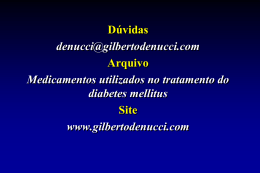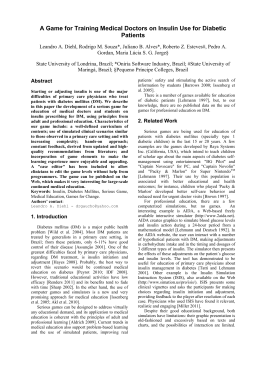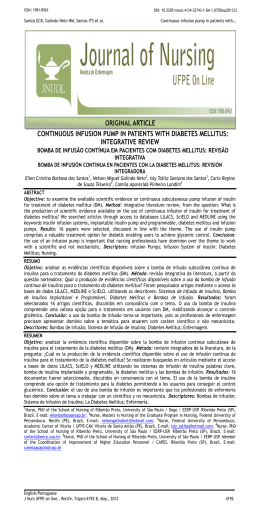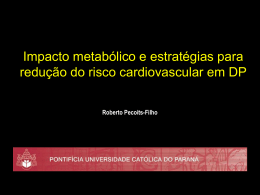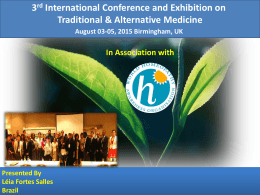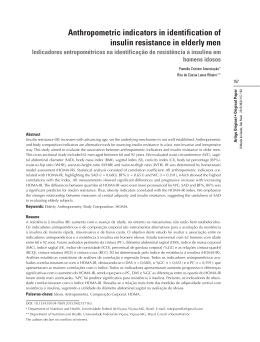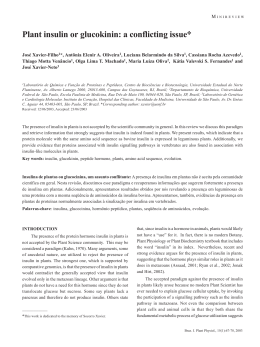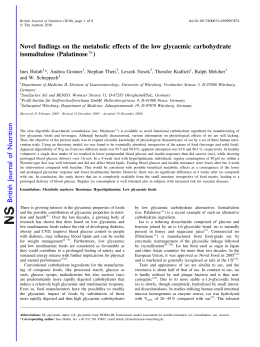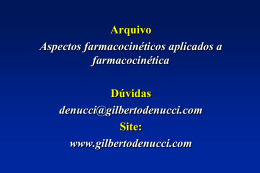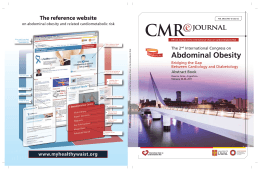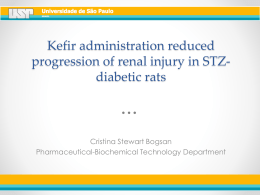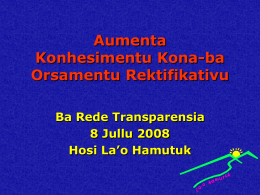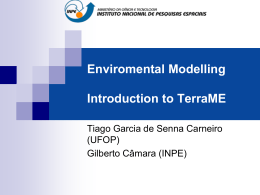Dúvidas [email protected] Arquivo Medicamentos utilizados no tratamento do diabetes mellitus Site www.gilbertodenucci.com Diabetes Mellitus Definição Doença em que o organismo não produz ou utiliza inadequadamente a insulina, o hormônio hipoglicemiante, o que leva a estado de hiperglicemia crônica Glucose tolerance in normal person and in a person with diabetes Guyton & Hall. Textbook of Medical Physiology. Tenth Edition. Principais tipos de Diabetes Mellitus Diabetes Mellitus tipo 1 (juvenil) O DM tipo 1 resulta primariamente da destruição das células pancreáticas tipo beta. Inclui casos decorrentes de doença auto-imune e aqueles nos quais a causa da destruição das células beta não é conhecida Principais tipos de Diabetes Mellitus Diabetes Mellitus tipo 1 (juvenil) • Corresponde a 5-10% do total de casos. A forma rapidamente progressiva é geralmente observada em crianças e adolescentes. A forma lentamente progressiva ocorre geralmente em adultos sendo referida como diabetes latente autoimune do adulto (LADA) Principais tipos de Diabetes Mellitus Diabetes Mellitus tipo 2 (adulto) O DM tipo 2 resulta de graus variáveis de resistência à insulina e deficiência relativa de secreção de insulina. A maioria dos pacientes tem excesso de peso Principais tipos de Diabetes Mellitus Diabetes Mellitus tipo 2 (adulto) Corresponde a 90-95% do total de casos. O diagnóstico é feito geralmente a partir dos 40 anos de idade embora possa ocorrer mais cedo principalmente em associação com a obesidade Diabetes Mellitus tipo 1 x Diabetes Mellitus tipo 2 Tipo 1 Tipo 2 Início < 30 anos > 30 anos História familiar de Diabetes Mellitus Raro Comum Peso corporal Não obeso Obeso Cetoacidose Comum Raro Tratamento com insulina Todos pacientes Alguns pacientes Auto-imunidade Sim Não Prevalência na população adulta 0.5% 5% Associação com HLA Sim Não Complicações comuns do diabetes tipo 2 Monografia de Glucovance – Site: http://www.merck.com.br/pdf/glucovance_monografia.pdf Intensive glycemic control and risk for microvascular complications Overview of insulin replacement therapy — The Journal of Family Practice - August 2009 (Vol. 58, No. 8) Intensive glycemic control and risk for MI and microvascular complications Overview of insulin replacement therapy — The Journal of Family Practice - August 2009 (Vol. 58, No. 8) Maiores reduções da HbA conferem maior proteção contra as complicações do diabetes Monografia de Glucovance – Site: http://www.merck.com.br/pdf/glucovance_monografia.pdf Insulina Proteína formada por 51 aminoácidos contidos no interior de 2 cadeias peptídicas: uma cadeia A com 21 aminoácidos e uma cadeia B com 30 aminoácidos As cadeias peptídicas são conectadas por duas pontes dissulfeto e, além disso, há uma outra ponte dissulfeto que liga as posições 6 e 11 da cadeia A Insulina Insulina ● = Carbono ● = Oxigênio ● = Nitrogênio, ● = Enxofre Insulina A insulina tende a formar dímeros em solução e hexâmeros na presença do zinco Dímero Hexâmero Hexâmero Insulina Site: http://www.nature.com/nrd/journal/v4/n5/images/nrd1718-f2.jpg Protein Crystal Recombinant Human Insulin Site: http://mix.msfc.nasa.gov/IMAGES/HIGH/9802450.jpg Insulina A insulina endógena circulante tem meia-vida de 3-5 minutos É catabolizada por insulinases no fígado, nos rins e na placenta sendo que cerca de 50% da insulina são removidos em uma única passagem pelo fígado Insulina A insulina é sintetizada nas células pancreáticas tipo beta das ilhotas de Langerhans Insulina Forma-se inicialmente um pré-pró-hormônio insulínico Este pré-pró-hormônio é clivado para formar uma próinsulina que, em sua maior parte, é clivada adicionalmente liberando o peptídeo C para formar a insulina Insulina Pró-insulina Peptidases da célula pancreática tipo beta Insulina Peptídeo C livre Controle da liberação de insulina Transportador de Glicose (1-5) Transportadores da glicose em humanos GLUT-1 GLUT-2 GLUT-3 Todos os tecidos Captação basal de glicose Fígado e células pancreáticas tipo beta Captação de glicose na hiperglicemia Todos os tecidos Captação basal de glicose GLUT-4 Músculo esquelético e tecido adiposo Captação de glicose dependente de insulina GLUT-5 Intestino delgado e espermatozóides Transportador de frutose Ação da Insulina Captação de glicose Insulina Fosforilação Fusão GLUT-4 Translocação Effect of insulin in enhancing the concentration of glucose inside muscle cells Guyton & Hall. Textbook of Medical Physiology. Tenth Edition. Schematic of the insulin receptor Guyton & Hall. Textbook of Medical Physiology. Tenth Edition. The actions of insulin and glucagon in liver, muscle and adipose tissue on the overall flow of fuels http://www.ncbi.nlm.nih.gov/books/bv Insulin Secretion Insulin Secretion Insulin Meal Postpradial State Postabsorbtive State O Glucose oxidation Glucose Glycerol Insulin permits rapid entry of glucose into muscle and fat cell O Glucose Fatty acid Triglycerides O CO2 + H2 O Glucose Glucose taken up by muscle Glucose taken up by fat Glucose Circulation Circulation Liver O O Glucose Glucose Glycogen Adipocyte Efeitos da insulina no metabolismo Carboidratos Aumenta o transporte de glicose Aumenta a síntese de glicogênio Inibe a glicogenólise Inibe a gliconeogênese Lipídeos Aumenta a atividade da lipoproteína lipase Aumenta o armazenamento de gordura nos adipócitos Aumenta a síntese de lipoproteínas no fígado Inibe a lipólise Inibe a oxidação de ácidos graxos Proteínas Aumenta o transporte de aminoácidos Aumenta a síntese de proteínas Insulinas de Mamíferos Rapid-acting analogue (clear) • • • • • Onset: 10–15 min Peak: 60–90 min Duration: 4– 5 h Humalog® (insulin lispro) NovoRapid® (insulin aspart) Insulin LisPro Insulina Lispro e Aspart Intermediate-acting (cloudy) • • • • • • Onset: 1–3 h Peak: 5–8 h Duration: up to 18 h Humulin®-N Humulin®-L Novolin®ge NPH Long-acting (cloudy) • • • • Onset: 3–4 h Peak: 8–15 h Duration: 22–26 h Humulin®-U Extended long-acting analogue • Onset: 90 min • Duration:24 h • Lantus®* (insulin glargine) Insulina Glarginina (Lantus) Premixed (cloudy) • A single vial contains a fixed ratio of insulin (% rapid- or fast-acting to % intermediateacting insulin) • Humalog® Mix25TM • Humulin® (20/80, 30/70) • Novolin®ge (10/90, 20/80, 30/70, 40/60, 50/50) Terapia com insulina Insulina plasmática em não diabéticos µU/mL 40 30 20 10 0 Glicemia em não diabéticos mg/dL 120 100 80 8am 10 12 2pm 4 6 Desjejum Almoço 8 10 12 2am 4 Jantar Lanche 6 8am Terapia com insulina Regime misto NPH Regular NPH + Regular NPH + Regular Insulina Ultralente Regular Ultralente 8am 10 12 2pm 4 6 Ultralente + Regular Regular 8 10 12 2am 4 Regular 6 8am Pacientes em uso de CSII nos EUA 100.000 100.000 90.000 80.000 70.000 60.000 50.000 40.000 30.000 20.000 10.000 81.000 60.000 42.000 35.000 26.500 15.000 11.400 6.600 8.700 90 91 92 93 20.000 94 Ano 95 96 97 98 99 00 Controle de glicemia em uso de CSII n Idade média (anos ± DP) HbA1c* préCSII (%) HbA1c* pósCSII (%) P Folow-up (meses) 143 34 ± 13 8.28 7.46 <0.001 42 Bode (adolescentes) 50 14.9 ± 2.6 9.64 8.24 <0.001 42 Rudolph and Hirsch 107 36 ± 10.4 7.6 7.1 <0.0001 36 Chanteleau 116 29 ± 1 7.7 6.7 <0.001 54 Roland 25 13.8 ± 2.1 8.4 7.5 0.02 12 Autores Bode (adultos) * mg/dL Controle de glicemia: adolescentes x adultos 10 9 HbA1c (%) 9.64 * 8.24 8.28 * 7.46 8 7 6 Adolescentes n = 50 Adultos n=413 Pré-CSII Pós-CSII * P < 0.001 Hipoglicemia pré e pós CSII n Idade média (anos ± DP) Hipoglicemia pré-CSII (%) Hipoglicemia pós-CSII (%) P 55 39.2 ± 12.9 138 22 <0.0001 Rudolph and Hirsch 107 36 ± 10.4 73.2 19.2 <0.0001 Chanteleau 116 29 ± 1 ND 10 25 13.8 ± 2.1 134 76 Autores Bode Roland ND – Não disponível 0.01 Hipoglicemia pré e pós CSII 150 138 100 39 50 0 22 Pré CSII 1 ano 36 26 2 anos 3 anos -------------------CSII---------------- 4 anos Redução no número de episódios de cetoacidose após uso de CSII 0,5 0,4 Eventos por ano 0,3 0,3 0,2 0,1 0,1 0,1 0 * P < 0.001 * 0,01 Adolescentes n = 43 Pré-CSII Adultos n = 229 Pós-CSII Endocr J. 2011 Aug 9. Effects of a novel short-term continuous subcutaneous insulin infusion program evaluated by continuous glucose monitoring on young adult type 1 diabetic patients in Taiwan. Lin CH, Huang CH, Tsai JS, Hsieh SH, Sun JH, Huang BY, Huang MJ, Huang YY. Source Division of Endocrinology and Metabolism, Department of Internal Medicine, Chang Gung Memorial Hospital and Chang Gung University, Taiwan. Abstract The aim of this study is to evaluate the effectiveness of blood sugar control by a short-course reinforcement program, consisting of using continuous subcutaneous insulin infusion (CSII) and continuous glucose monitoring (CGM) for young adult type 1 diabetic patients. Twenty-six pump-naïve type 1 diabetic patients were successively enrolled in two years. The mean disease duration was 13 years and the mean HbA1c was 8.8 %. Initially, a 3-day course of CGM was used to evaluate the baseline glycemic status of the subjects, followed by 6-day intensive insulin adjustment by CSII therapy. Thereafter, a second course of CGM was performed to evaluate the effectiveness of our outcomes in comparison to the initial measurements. All participants received necessary education and instruction as required throughout the course of the program. The glucose variability as measured by standard deviation of plasma glucose and mean amplitude of glucose excursion decreased significantly (67.8 ± 2.7 to 52.0 ± 1.8 mg/dL and 140.4 ± 6.5 to 105.5 ± 5.3 mg/dL, p < 0.001). The hypoglycemic events noted per patient were reduced by 46.4% (p = 0.003) and occurred significantly less often during nocturnal periods (-63.2%, p = 0.002). Following the adjustment, the mean daily insulin requirement was reduced by 28.05% (from 0.82 to 0.59 IU/kg) and the new proportion of 40% as basal insulin was found. The short-term CSII program provided significant improvement in blood sugar control for Type 1 diabetic patients, by reducing hypoglycemic events, glucose excursion, and insulin dosage in our examined subjects. Inhaled Insulin Device. The Exubera inhaled insulin device is closed for portability and opened before use. It is activated after insertion of an insulin blister. The release unit must be changed every 2 weeks. Exubera Sulfoniluréias Sulfoniluréias (clorpropamida, glipizida, gliclazida e glimepirida) glibenclamida, Estimulam a secreção de insulina ligando-se a um receptor específico na célula beta o qual determina o fechamento dos canais de potássio dependentes de ATP resultando em despolarização da célula Controle da liberação de insulina Chlorpropamide (t ½ = 36 h) (1st generation) Site: http://en.wikipedia.org/wiki/File:Chlorpropamide.svg Gliclazide (1st generation) Site: http://en.wikipedia.org/wiki/File:Gliclazide.svg Tolbutamide (1st generation) Site: http://en.wikipedia.org/wiki/File:Tolbutamide.svg Glibenclamide (t ½ = 10h) (2st generation) Site: http://en.wikipedia.org/wiki/File:Glibenclamide.svg Glipizide ( t ½ = 2-4 hs) (2st generation) Site: http://en.wikipedia.org/wiki/File:Glipizide.svg Glimepiride (t ½ = 5 h) (3st generation) Site: http://en.wikipedia.org/wiki/File:Glimepiride.svg Meglitinidas Derivados do ácido benzóico (repaglinida) Derivados da d-fenilalanina (nateglinida) Estimulam a secreção de insulina ligando-se a receptores na célula beta em sítios distintos dos canais de potássio dependentes de ATP. Controle da liberação de insulina Repaglinide Nateglinide Biguanides Suggested mode action: Reduces hepatic glucose production and glycogen metabolism Improves insulin resistance via enhancing insulin-mediated glucose uptake by skeletal muscle Lowers triglycerides and total cholesterol levels Raises high-density lipoprotein (HDL) levels and causes weight loss Metformin Helpful in stabilizing blood sugar in brittle diabetics on insulin therapy Indicated alone in obese, mild diabetics because, unlike insulin, it does not enhance lipogenesis Glucose Glucose-PO4 Lipogenesis Krebs cycle Blood Glucose, mg/100ml Inhibition of oxidative metabolism Lactic acid Blood glucose (diabetic) 100 Blood glucose (nondiabetic) 15 Blood insulin Hours 0 1 2 3 Insulin Microunits/ml Pyruvic acid Administration 200 Metformin Tiazolidinedionas • Rosiglitazona • Pioglitazona Thiazolidinedione Site: http://en.wikipedia.org/wiki/File:Thiazolidinedione.png Rosiglitazone Site: http://www.3dchem.com/imagesofmolecules/Rosiglitazone.gif Pioglitazone Site: http://www.dalton.com/images/pioglitazone.gif Tiazolidinedionas • • • • Reduz glicose plasmática Aumenta uptake periférico de glicose Reduz níveis de triglicerídeos Aumenta a sensibilidade à insulina em tecidos periféricos Peroxisome proliferator-activated receptor (PPAR) α (alpha) - liver, kidney, heart, muscle, adipose tissue and others β/δ (beta/delta) - expressed in many tissues but markedly in brain, adipose tissue and skin γ (gamma) - although transcribed by the same gene, this PPAR through alternative splicing is expressed in three forms: • γ1 - expressed in virtually all tissues, including heart, muscle, colon, kidney, pancreas, and spleen • γ2 - expressed mainly in adipose tissue (30 amino acids longer) • γ3 - expressed in macrophages, large intestine, white adipos tissue. Alternative splicing resulting in protein isoforms Site: http://en.wikipedia.org/wiki/File:Splicing_overview.jpg Peroxisome proliferator - activated receptor pathway diagram Site: http://en.wikipedia.org/wiki/File:PPAR-diagram.png Thiazolidinediones Effect of rosiglitazone and metformin on subcutaneous abdominal adipose tissue (SCAAT) and visceral adipose tissue Thiazolidinediones, insulin resistance and obesity: finding a balance - Journal compilation ª 2006 Blackwell Publishing Ltd Int J Clin Pract, October 2006, 60, 10, 1272–1280 Bioactive GLP-1(7-36)amide and GIP (1-42) are released from the small intestine after meal ingestion and enhance glucose stimulated insulin secretion (incretin action). DPP-4 rapidly converts GLP-1 and GIP to their inactive metabolites GLP-1 (9-36) and GIP (3-42) in vivo. Inhibition of DPP-4 activity prevents GLP-1 and GIP degradation, thereby enhancing incretin action. Biology of Incretins: GLP-1 and GIP - GASTROENTEROLOGY 2007;132:2131–2157 GIP actions in peripheral tissues. Biology of Incretins: GLP-1 and GIP - GASTROENTEROLOGY 2007;132:2131–2157 Exenatide (Byetta) • • • • • • 53% idêntico ao GLP-1 Resistente a DPP-IV Aumenta a secreção de insulina Reduz a secreção de glucagon Aumenta o tempo de esvaziamento gástrico Sensação de saciedade – provoca queda de peso GLP-1 actions in peripheral tissues. The majority of the effects of GLP-1 are mediated by direct interaction with GLP-1Rs on specific tissues. However, the actions of GLP-1 in liver, fat, and muscle most likely occur through indirect mechanisms. Biology of Incretins: GLP-1 and GIP - GASTROENTEROLOGY 2007;132:2131–2157 The inactivation process of GLP-1 by DPP-IV. GLP-1 based therapy for type 2 diabetes - european journal of pharmaceutical sciences 2 8 ( 2 0 0 6 ) 96–1081 Saxagliptin Site: http://en.wikipedia.org/wiki/File:Saxagliptin.svg Sitagliptin Site: http://en.wikipedia.org/wiki/File:Sitagliptin.svg Vildagliptin Site: http://en.wikipedia.org/wiki/File:Vildagliptin_Structural_Formulae.png Mechanism of action of vildagliptin. In response to a meal, active glucagonlike peptide-1 (GLP-1) is secreted by the L cells of the intestines. Without the presence of vildagliptin, GLP-1 is rapidly inactivated and degraded by the enzyme dipeptidyl peptidase IV (DPP4); when vildagliptin is present, vildagliptin binds to DPP4, allowing GLP-1 to remain active. Active GLP-1 causes the pancreas to increase insulin release and decrease glucagon release. Vildagliptin: A novel oral therapy for type 2 diabetes mellitus - Am J Health-Syst Pharm—Vol 64 Jun 15, 2007 Target 2 physiologic glucose-lowering actions with a single oral agent Glucose-dependent mechanism target 2 key defects: insulin release and hepatic glucose production Site: www.januvia.com In a single-dose pharmacokinetic study of patients with type 2 diabetes Rapidly increased active incretins (GLP-1 and GIP) through a full 24 hours Site: www.januvia.com A single oral dose sustains powerful DPP-4 inhibition for a full 24 hours Site: www.januvia.com Significantly improved key meassures of beta-cell and alpha-cell responsiveness to glucose Site: www.januvia.com Amylin 37 amino acid compound Co-secreted with insulin from beta cells Deficient in type 1 and type 2 DM Renal clearance Amylin - Physiological effects 1. Suppression of endogenous glucagon production (especially in the postprandial state) 2. Reduction in postprandial hepatic glucose production 3. Reduction in gastric emptying time 4. Centrally mediated induction of satiety 5. Reduction in postprandial glucose levels Pramlintide Synthetic analogue of Amylin (3 amino acid substitutions with proline for native amino acids) Subcutaneous administration Pramlintide The most commonly reported adverse effects associated with pramlintide use in type 1 DM were nausea, anorexia, and hypoglycemia in these studies. Mean percent changes in lipid values in 203 type 2 diabetic patients on placebo and 3 different doses of pramlintide for 4 weeks. Byron J Hoogwerf, Krupa B Doshi, Dima Diab Pramlintide, the synthetic analogue of amylin: physiology, pathophysiology, and effects on glycemic control, body weight, and selected biomarkers of vascular risk. Vascular Health and Risk Management 2008:4(2) 355–362 Diabetic Neuropathy 1 - accumulation of advanced glycation end products 2 - formation of reactive oxygen species 3 - activation of protein kinase C, development of diabetic microangiopathy (disease of the small blood vessels) 4 - increased aldose reductase activity The Polyol Pathway Site: http://www.medbio.info/images/Time%203-4/new_se11.gif Epalrestat SGLT2 mediates glucose reabsorption in the kidney. SGLT2 catalyzes the active transport of glucose (against a concentration gradient) across the luminal membrane by coupling it with the downhill transport of Na+. The inward Na+ gradient across the luminal epithelium is maintained by active extrusion of Na+ (driven by ATP) across the basolateral surface into the intercellular fluid, which is in equilibrium with the blood. Glucose passively diffuses of the cell down a concentration gradient via basolateral facilitative transporters, GLUT2 (and GLUT1). A Paradigm Shift in Diabetes Therapy — Dapagliflozin and Other SGLT2 Inhibitors - Figure 1. Comparison of sodium-Glucose Contransporters A Paradigm Shift in Diabetes Therapy — Dapagliflozin and Other SGLT2 Inhibitors - tab 01 Normal glucose homeostasis. Diagram outlining the hormonal interactions that are important in regulating normal glucose homeostasis. Normal fasting glucose homeostasis involves the hormonal regulation of glucose utilization and production, as well as the filtration and reabsorption of glucose by the kidney. Under basal conditions, glucose uptake by the tissues is matched by glucose production from the liver; this enables fine regulation of glucose at a very fixed level. Gluconeogenesis in the liver helps prevent hypoglycemia. Adapted from DeFronzo RA. Pharmacologic therapy for type 2 diabetes mellitus. A Paradigm Shift in Diabetes Therapy — Dapagliflozin and Other SGLT2 Inhibitors - Ann Intern Med 131(4):281-303, 1999 – fig 02 Renal glucose handling before and following inhibition of SGLT2. With gradual infusion of glucose, as the plasma glucose concentration increases, the reabsorption progressively increases following the line marked reabsorption curve (in red). At plasma glucose concentrations <200 mg/dL, all the filtered glucose is reabsorbed and there is no excretion. When glucose reaches a threshold, around 200-250 mg/dL, the maximum capacity of the renal tubule to reabsorb glucose -- or the Tmax - is exceeded and once it passes this, glucose begins to be excreted into the urine (green line, labeled “excretion”). The breaking point, however, is not abrupt -- splay, which represents glucose excretion in the urine before saturation (Tmax) is fully attained; and is explained by some nephrons releasing glucose at a slightly lower threshold, some a bit higher; and the relatively low affinity of the Na-glucose carriers. The dotted yellow lines depict renal glucose handling after SGLT2 inhibition. The SGLT2 inhibitors lower the Tmax of glucose, which in turn increases the excretion of glucose via the kidneys A Paradigm Shift in Diabetes Therapy — Dapagliflozin and Other SGLT2 Inhibitors - Figure 4. Acarbose É um inibidor competitivo de α-glicosidases intestinais tais como maltase, isomaltase, sacarase e glicoamilase, retardando a absorção de carboidratos Activation and inactivation of poly(ADP-ribose) polymerase (PARP): interactions with specific signal-transduction pathways Site: http://www.nature.com/nrd/journal/v4/n5/images/nrd1718-f2.jpg Insulina Liberação de insulina Canal de potássio dependente de ATP, sensível à gliburida Exocitose Ca2+ Ca2+ K+ Ca2+ Insulina ATP Célula pancreática tipo beta estimulada por glicose Ca2+ Ca2+ Retículo endoplasmático Significantly improved measures of insulin synthesis and release from the beta cell Site: www.januvia.com Structures of (A) the proglucagon gene, (B) mRNA, and (C) protein. (D) Tissue-specific posttranslational processing of proglucagon in the pancreas leads to the generation of Glicentinrelated polypeptide (GRPP), glucagon (GLUC), intervening peptide-1 (IP-1), and major proglucagon fragment (MPGF), whereas glicentin, oxyntomodulin (OXM), intervening peptide-2 (IP-2), and GLP-1 and GLP-2 are liberated after proglucagon processing in the intestine and brain. Biology of Incretins: GLP-1 and GIP - GASTROENTEROLOGY 2007;132:2131–2157 (A) ProGIP gene, (B) mRNA, and (C) protein. Bioactive GIP is generated from its proGIP protein precursor by posttranslational cleavage at single arginine residues that flank GIP. Biology of Incretins: GLP-1 and GIP - GASTROENTEROLOGY 2007;132:2131–2157 Structure, synthesis and metabolism of insulin and glucagon 01 - Structure of the primary transcript of RNA 02 -Mature messenger (m) RNA after exicision of the introns 03 - Structure of proinsulin after cleavage of the signal sequence from pre-proinsulin 04 - Cleavage of the C peptide leaving biologically active insulin 05 - Packaging of insulin and C-peptide in secretory granules for storage and release http://www.ncbi.nlm.nih.gov/books/bv Synthesis of glucagon and post-translational processing of the proglucagon gene Schematic representation of the major products of proglucagon in the human pancreas and intestine. The processing of glucagon in the gut produces two important peptides - glucagon-like peptide 1 (GLP-1) and oxyntomodulin - which are known as incretins as they increase the insulin response to glucose. GRPP, glucagon related pancreatic peptide; IP, intervening peptide http://www.ncbi.nlm.nih.gov/books/bv Ação da insulina Domínio de ligação da insulina Domínio intracitoplasmático NH2 NH2 β Insulina Receptor de insulina ativado (ação tirosinaquinase intrínseca) β COOH COOH COOH Estrutura do receptor de insulina Receptor de insulina Cascata de fosforilações (GLUT- 4, transferrina, LDL-R e IGF 2-R) Tratamento do Diabetes Mellitus Nova modalidade de tratamento CSII (Continuous subcutaneous insulin infusion) Terapia que utiliza bomba de infusão subcutânea contínua de insulina indicada quando 3 ou 4 aplicações diárias ainda são insuficientes para o controle da glicemia Também indicada para pacientes motivados com cotidiano que não permite a terapia convencional com auto-aplicações de insulina Tratamento do Diabetes Mellitus Objetivo Glicemia de jejum em torno de 110 mg/dL Glicemia após 2 h de refeição em torno de 140 mg/dL Thiazolidinediones: Clinical Rationale and Adverse Effects Rosiglitazone Thiazolidinediones increase sensitivity of cells to existing insulin Adipocyte Muscle O Glucose oxidation Glucose Glycerol O Glucose O CO2 + H2 O Glucose Glucose taken up by muscle Reduced triglycerides increased HDL and LDL Hepatic glucose production reduced Liver Fatty acid Triglycerides O O Glucose Glucose Glycogenolysis Glycogen Adverse reactions reported in ≥5.0% of patients and more commonly than in patients given placebo, regardless of investigator assessment of causality, number of patients(%) Site: www.januvia.com Proven 24-hours glycemic control Dosage for patients with renal insufficency Site: www.januvia.com Fatores de risco para o desenvolvimento de doença coronariana nos pacientes com diabetes tipo 2 Monografia de Glucovance – Site: http://www.merck.com.br/pdf/glucovance_monografia.pdf Relação contínua entre os níveis de HbA após o tratamento do diabetes e a incidência de complicações do diabetes Monografia de Glucovance – Site: http://www.merck.com.br/pdf/glucovance_monografia.pdf Taxas constantemente baixas de controle glicêmico em pacientes tratados na comunidade Monografia de Glucovance – Site: http://www.merck.com.br/pdf/glucovance_monografia.pdf O desenvolvimento de resistência à insulina e o comprometimento relativo da secreção de insulina fazem parte da progressão do diabetes tipo 2 Monografia de Glucovance – Site: http://www.merck.com.br/pdf/glucovance_monografia.pdf Estratégia para o controle mais intensivo do diabetes, como uso mais precoce do tratamento combinado Monografia de Glucovance – Site: http://www.merck.com.br/pdf/glucovance_monografia.pdf Propriedades farmacocinéticas de Glucovance e da associação livre de metformina e glibenclamida Monografia de Glucovance – Site: http://www.merck.com.br/pdf/glucovance_monografia.pdf Esquema terapêutico diário de um paciente que apresenta diabetes tipo 2 e doenças concomitantes típicas. Este paciente precisa tomar um total de 19 comprimidos por dia, em quatro horários diferentes. Monografia de Glucovance – Site: http://www.merck.com.br/pdf/glucovance_monografia.pdf Selective insulin resistance in T2DM. In skeletal muscle, insulin action on glucose transport and utilisation is impaired due to decreased IRS tyrosine phosphorylation and activity of the kinases PI 3kinase and Akt. In endothelial cells (EC), the defect in insulin-stimulated PI 3-kinase/Akt activity is also responsible for reduced eNOS synthesis and nitric oxide (NO) generation, which contributes to endothelial dysfunction. The defective glucose metabolism leads to increased insulin concentrations (hyperinsulinaemia), which stimulate the Shc/MAP kinase pathway normally or more effectively than normal in vascular smooth muscle cells (VSMC), leading to increased secretion of plasminogen activator inhibitor-1 (PAI-1) and endothelin-1 (ET-1), which further exacerbate endothelial dysfunction. PY, tyrosine phosphorylation; eNOS, endothelial nitric oxide synthase. Pathophysiology of type 2 diabetes: Rationale for different oral antidiabetic treatment strategies - Diabetes Res Clin Pract. 2005 Jun;68 Suppl1:S22-9. Mechanisms of action of thiazolidinediones (TZDs). The TZDs act by binding to the nuclear receptor peroxisome proliferator activated receptors-γ (PPARγ), thereby inducing expression of genes involved in glucose and lipid metabolism in adipocytes, as well as secretion of the adipokines adiponectin and tumor necrosis factor (TNF)-α. In addition, the TZDs inhibit hepatic gluconeogenesis, stimulate lipid uptake and oxidation by the liver, and promote glucose oxidation by the skeletal muscle. The ultimate effects are to lower circulating FFA and enhance whole-body insulin sensitivity. GLUT4, insulin-stimulated glucose transporter; CAP, cbl-associated protein involved in insulin signaling; LPL, lipoprotein lipase; FATP, fatty acid transport protein; ACS, acetyl CoA synthase; UCP, uncoupling protein; FFA, free fatty acid; PEPCK, phosphoenolpyruvate carboxykinase. Pathophysiology of type 2 diabetes: Rationale for different oral antidiabetic treatment strategies - Diabetes Res Clin Pract. 2005 Jun;68 Suppl1:S22-9. Potential mechanisms leading to β-cell dysfunction in T2DM. Potential Causes of β-Cell Dysfunction in Type 2 Diabetes Reversible metabolic abnormalities Glucotoxicity Lipotoxicity Hormonal changes Inadequate incretin action Increased glucagon secretion Genetic abnormalities of β-cell proteins Glucokinase, SUR1/Kir6, IPF-1, HNF-4α, HNF-2α, Insulin receptor, IRS-1 Reduction of β-cell mass Increase in amyloid Apoptosis SUR1/Kir6, complex formed by the sulphonylureas receptor (SUR) and the K+ channel; IPF-1, insulin promoter factor-1; HNF, hepatocyte nuclear factor; IRS-1, insulin receptor substrate-1. Pathophysiology of type 2 diabetes: Rationale for different oral antidiabetic treatment strategies - Diabetes Res Clin Pract. 2005 Jun;68 Suppl1:S22-9. Schematic flow-chart of the use of hypoglycaemic drugs in the therapy of T2DM. Use of Hypoglycaemic drugs in the therapy of T2DM Diet + Physical activity HbA1c>7% Insulin-sensitizing agent and/or insulin secretagogue HbA1c>7% Basal insulin (NPH/Glargine) Prandial insulin (Lispro/Aspart) FPG target: <100 mg/dl PPG target: <140 mg/dl When diet and physical activity fail to achieve an HbA1c value of <7%, insulin-sensitizing agents and insulin secretagogues are used alone or in various combinations. If the HbA1c target of <7% is still not met, insulin therapy should be considered. A ‘basal’ insulin, such as NPH insulin or glargine, is used to lower fasting plasma glucose (FPG) below 100 mg/dl; a ‘prandial’ insulin, preferably a short-acting analogue such as lispro or aspart, is used to control post-prandial glucose (PPG) excursions below 140 mg/dl. Pathophysiology of type 2 diabetes: Rationale for different oral antidiabetic treatment strategies - Diabetes Res Clin Pract. 2005 Jun;68 Suppl1:S22-9. Change in weight (%) by category in patients with type 2 diabetes treated with rosiglitazone plus metformin (n ¼ 10,321). Thiazolidinediones, insulin resistance and obesity: finding a balance - Journal compilation ª 2006 Blackwell Publishing Ltd Int J Clin Pract, October 2006, 60, 10, 1272–1280 Mean change in weight in the United Kingdom Prospective Diabetes Study (overweight cohort). Thiazolidinediones, insulin resistance and obesity: finding a balance - Journal compilation ª 2006 Blackwell Publishing Ltd Int J Clin Pract, October 2006, 60, 10, 1272–1280 Effect of rosiglitazone 8 mg/day vs. placebo on intra-abdominal, subcutaneous and intrahepatic fat Thiazolidinediones, insulin resistance and obesity: finding a balance - Journal compilation ª 2006 Blackwell Publishing Ltd Int J Clin Pract, October 2006, 60, 10, 1272–1280 The time course of changes in serum alanine aminotransferase (ALT) and aspartate aminotransferase (AST) during treatment with rosiglitazone Thiazolidinediones, insulin resistance and obesity: finding a balance - Journal compilation ª 2006 Blackwell Publishing Ltd Int J Clin Pract, October 2006, 60, 10, 1272–1280 The pathway of muscle glycogen synthesis. GLUT 4 glucose transporter 4; UDP uridine 5’-diphosphate. Etiology of Insulin Resistance - The American Journal of Medicine (2006) Vol 119 (5A), 10S-16S GLUT 4 = glucose transporter 4; IRS = insulin-receptor substrate; PI 3-kinase = phosphatidylinositol 3-kinase; nPKC = novel protein kinase C. Etiology of Insulin Resistance - The American Journal of Medicine (2006) Vol 119 (5A), 10S-16S The mechanism of fatty acid-induced insulin resistance in muscle (A) and liver (B). Alternative causes of insulin resistance (IR) mediated via fat accumulation in skeletal muscle and liver. Etiology of Insulin Resistance - The American Journal of Medicine (2006) Vol 119 (5A), 10S-16S Antidiabetogenic effects of GLP-1 GLP-1 based therapy for type 2 diabetes - european journal of pharmaceutical sciences 2 8 ( 2 0 0 6 ) 96–1081 GLP-1 mimetics under development GLP-1 based therapy for type 2 diabetes - european journal of pharmaceutical sciences 2 8 ( 2 0 0 6 ) 96–1081 Potency and selectivity of some DPP-IV inhibitors GLP-1 based therapy for type 2 diabetes - european journal of pharmaceutical sciences 2 8 ( 2 0 0 6 ) 96–1081 Structures of DPP-IV inhibitors. GLP-1 based therapy for type 2 diabetes - european journal of pharmaceutical sciences 2 8 ( 2 0 0 6 ) 96–1081 DPP-IV inhibitors in various clinical phases GLP-1 based therapy for type 2 diabetes - european journal of pharmaceutical sciences 2 8 ( 2 0 0 6 ) 96–1081 Physiological processes modulated by DPP-IV activity GLP-1 based therapy for type 2 diabetes - european journal of pharmaceutical sciences 2 8 ( 2 0 0 6 ) 96–1081 Biochemical reactions for the storage of triglycerides in adipose tissue. http://www.ncbi.nlm.nih.gov/books/bv Major aspects of lipid turnover in man http://www.ncbi.nlm.nih.gov/books/bv The formation of ketone bodies Acetyl CoA, formed from pyruvate and fatty oxidation hydrolysis enters the TCA cycle. In diabetes or fasting, oxaloacetate is consumed by the gluconeogenic pathway. There is reduced incorporation of acetyl CoA into citrate (x) and hence acetyl CoA is converted to form ketone bodies. http://www.ncbi.nlm.nih.gov/books/bv The family of glucose transporters (GLUTs 1–5) http://www.ncbi.nlm.nih.gov/books/bv Therapies for DM - 1 Human insulin replacement http://www.ncbi.nlm.nih.gov/books/bv Therapies for DM - 1 Human insulin replacement http://www.ncbi.nlm.nih.gov/books/bv Increase in plasma insulin concentration after a sudden increase in blood glucose to two to three times the normal range Guyton & Hall. Textbook of Medical Physiology. Tenth Edition. Approximate insulin secretion at different plasma glucose levels Guyton & Hall. Textbook of Medical Physiology. Tenth Edition. Approximate plasma glucagon concentration at different blood glucose levels Guyton & Hall. Textbook of Medical Physiology. Tenth Edition. Changes in blood constituents in diabetic coma, showing normal values (light bars) and diabetic coma values (dark bars) Guyton & Hall. Textbook of Medical Physiology. Tenth Edition. Action of insulin on the adipocyte The effects of insulin on adipose tissue. http://www.ncbi.nlm.nih.gov/books/bv insulin signaling system in healthy normal glucose tolerant A) and T2DM B) subjects. Pioglitazone and alogliptin combination therapy in type 2 diabetes: a pathophysiologically sound Treatment - Vascular Health and Risk Management 2010:6 671–690 – Fig 01 The triumvirate: insulin resistance in liver and muscle with impaired insulin secretion represent the three core defects in T2DM. Reproduced with permission from DeFronzo RA. Lilly lecture. The triumvirate: Beta-cell, muscle, liver. Pioglitazone and alogliptin combination therapy in type 2 diabetes: a pathophysiologically sound Treatment - Vascular Health and Risk Management 2010:6 671–690 – Fig 02 Effect of thiazolidinedione (TZD) treatment on beta cell function. Pioglitazone and alogliptin combination therapy in type 2 diabetes: a pathophysiologically sound Treatment - Vascular Health and Risk Management 2010:6 671–690 – Fig 03 Pioglitazone positively affects the insulin signaling system resulting in improved glycemic control, generation of nitric oxide and decreased MAP kinase pathway activation. Pioglitazone and alogliptin combination therapy in type 2 diabetes: a pathophysiologically sound Treatment - Vascular Health and Risk Management 2010:6 671–690 – Fig 04 Effect of thiazolidinediones (TZDs) on body fat distribution. Pioglitazone and alogliptin combination therapy in type 2 diabetes: a pathophysiologically sound Treatment - Vascular Health and Risk Management 2010:6 671–690 – Fig 05 GLP-1 levels decline as glucose tolerance deteriorates A), whereas GiP levels are normal or elevated in patients with type 2 diabetes mellitus B). Pioglitazone and alogliptin combination therapy in type 2 diabetes: a pathophysiologically sound Treatment - Vascular Health and Risk Management 2010:6 671–690 – Fig 06 Percentage (%) of subjects achieving select HbA targets with alogliptin in Phase 3 trials. Pioglitazone and alogliptin combination therapy in type 2 diabetes: a pathophysiologically sound Treatment - Vascular Health and Risk Management 2010:6 671–690 – Fig 08 Necessity for hyperglycemic rescue* in Phase iii trials with alogliptin Pioglitazone and alogliptin combination therapy in type 2 diabetes: a pathophysiologically sound Treatment - Vascular Health and Risk Management 2010:6 671–690 – Fig 09 The ominous octet: pathophysiologic abnormalities in type 2 diabetes mellitus Pioglitazone and alogliptin combination therapy in type 2 diabetes: a pathophysiologically sound Treatment - Vascular Health and Risk Management 2010:6 671–690 – Fig 10
Download
